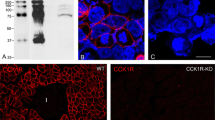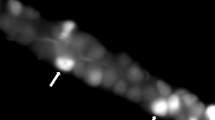Summary
The present report describes the ultrastructure of the enterochromaffin-like (ECL) cells in the stomach of the rat, hamster and guinea pig, and the ultrastructural consequences of long-term hypergastrinaemia evoked either by continuous infusion of synthetic human (Leu15)-gastrin-17 for 4 weeks (rats) or by daily treatment with large doses of the antisecretory agent omeprazole for 2–10 weeks (rats, hamsters and guinea pigs). As a result, the ECL cells increased greatly in size (maximal effect after 2 weeks of omeprazole treatment, no further gain in size after 4 or 10 weeks). Also the endoplasmic reticulum and Golgi area were enlarged. The most conspicuous feature of the ECL cells is the cytoplasmic vesicles, which are of varying size and either devoid of a dense core or with a small, often eccentrically located dense core. The vesicles probably represent the main storage site of the secretory products of the ECL cell. In addition, the cytoplasm contains granules, which differ from the vesicles in that they possess a more or less electron-dense core, surrounded by a narrow halo. The size of the vesicles ranged from small to very large, while the granules were uniformly small. Many vesicles were seen to lie very close together, some displaying an irregular outline (vacuole-like vesicles), at times giving the impression that they were undergoing fusion. The profile size (median value) of the vesicles was unaffected by gastrin infusion for 4 weeks. However, there was a tendency to a relative increase in the number of very small vesicles. In contrast, the vesicles became larger during the omeprazole treatment. Also, the number of vesicles that seemed to be engaged in fusion increased after omeprazole treatment but not after gastrin infusion. The observations support the view that ECL cells are influenced by gastrin. The effects of gastrin infusion and of omeprazole treatment on ECL cell ultrastructure were not completely identical. It cannot be excluded that the omeprazole-evoked achlorhydria evokes effects unrelated to those of hypergastrinaemia on the ECL cells, or that endogenous gastrins may evoke effects that are in some ways distinct from those of synthetic human (Leu15)-gastrin-17. Alternatively, the additional effects seen after long-term omeprazole treatment may reflect simply the duration of the hypergastrinaemic stimulus.
Similar content being viewed by others
References
Alumets J, El Munshid HA, Håkanson R, Liedberg G, Oscarson J, Rehfeld JF, Sundler F (1979) Effect of antrum exclusion on endocrine cells of rat stomach. J Physiol 286:145–155
Alumets J, El Munshid HA, Håkanson R, Hedenbro J, Liedberg G, Oscarson J, Rehfeld JF, Sundler F, Vallgren S (1980) Gastrin cell proliferation after chronic stimulation: Effect of vagal denervation or gastric surgery in the rat. J Physiol 298:558–569
Axelson J, Håkanson R, Rosengren E, Sundler F (1988) Hypergastrinaemia induced by acid blockade evokes enterochromaffnlike (ECL) cell hyperplasia in chicken, hamster and guinea-pig stomach. Cell Tissue Res 254:511–516
Capella C, Solcia E, Vassallo G (1969) Identification of six types of endocrine cells in the gastrointestinal mucosa of the rabbit. Arch Histol Jpn 30:479–495
Capella C, Vassallo G, Solcia E (1971) Light and electron microscopic identification of the histamine-storing argyrophil (ECL) cell in murine stomach and of its equivalent in other mammals. Z Zellforsch 118:68–84
Giraud AS, Yeomans ND (1981) Fine structure of the gastric mucosa and endocrine cells of the toad, Bufo marinus. Cell Tissue Res 218:663–668
Giraud AS, Yeomans ND (1982) Cell types of the gastric mucosa of a teleost, the river blackfish, Gasopsis marmoratus. Aust J Mar Freshwater Res 33:1103–1108
Giraud AS, Yeomans ND, St. John DJB (1979) Ultrastructure and cytochemistry of the gastric mucosa of a reptile, Tilliqua scinoides. Cell Tissue Res 1979:281–294
Håkanson R, Owman C, Sjöberg N-O, Sporrong B (1970) Amine mechanisms in enterochromaffin and enterochromaffin-like cells of gastric mucosa in various mammals. Histochemie 21:189–220
Håkanson R, Owman C, Sporrong B, Sundler F (1971) Electron microscopic identification of the histamine-storing argyrophil (enterochromaffin-like) cells in the rat stomach. Z Zellforsch 122:460–466
Håkanson R, Alumets J, Rehfeld JF, Ekelund M, Sundler F (1982) The life cycle of the gastrin granule. Cell Tissue Res 222:479–491
Håkanson R, Böttcher G, Sundler F, Vallgren S (1986a) Activation and hyperplasia of gastrin cells and enterochromaffin-like cells in the stomach. Int Symp Gastric Carcinoids. Digestion 35:[Suppl] 1:23–41
Håkanson R, Böttcher G, Ekblad E, Panula P, Simonsson M, Dohlsten M, Hallberg T, Sundler F (1986b) Histamine in endocrine cells in the stomach. A survey of several species using a panel of histamine antibodies. Histochemistry 86:5–17
Håkanson R, Blom H, Carlsson E, Larsson H, Ryberg B, Sundler F (1986c) Hypergastrinaemia produces trophic effects in stomach but not in pancreas and intestines. Regul Pept 13:225–233
Larsson H, Carlsson E, Mattsson H, Lundell L, Sundler F, Sundell G, Wallmark B, Watanabe T, Håkanson R (1986) Plasma gastrin and gastric enterochromaffinlike cell activation and proliferation. Studies with omeprazole and ranitidine in intact and antrectomized rats. Gastroenterology 90:391–399
Larsson H, Carlsson E, Håkanson R, Mattson H, Nilsson G, Seensalu R, Wallmark B, Sundler F (1988) Time-course of development and reversal of gastric endocrine cell hyperplasia after inhibition of acid secretion. Studies with omeprazole and ranitidine in intact and antrectomized rats. Gastroenterology 95:1477–1486
Ryberg B, Bishop AE, Bloom SR, Carlsson E, Håkanson R, Larsson H, Matsson H, Polak JM, Sundler F (1989) Omeprazole and ranitidine, antisecretagogues with different modes of action, are equally effective in causing hyperplasia of enterochromaffin-like cells in rat stomach. Regul Pept (in press)
Solcia E, Capella C, Buffa R, Usellini L, Fontana P, Frigerio B (1978) Endocrine cells of the gastrointestinal tract: General aspects, ultrastructure and tumor pathology. In: Grossman MI, Speranza V, Basso N, Lezoche E (eds) Gastrointestinal Hormones and Pathology of the Digestive System, Plenum Press, New York, pp 11–22
Solcia E, Capella C, Buffa R, Usellini L, Fiocca R, Sessa F (1987) Endocrine cells of the digestive system. In: Johnson LR (ed) Physiology of the Gastrointestinal Tract, Raven Press, New York, pp 111–130
Stadil F, Rehfeld JF (1973) Determination of gastrin in serum. An evaluation of the reliability of a radioimmunoassay. Scand J Gastroent 8:101–112
Tielemans Y, Håkanson R, Sundler F, Willems G (1989) Proliferation of enterochromaffin-like (ECL) cells in omeprazole-treated hypergastrinemic rats. Gastroenterology (in press)
Usellini L, Tenti P, Fiocca R, Capella C, Buffa R, Terenghi C, Polak JM, Solcia E (1983) The endocrine cells of the chicken proventriculus. Bas Appl Histochem 27:87–102
Weibel ER (1969) Stereological principles for morphometry in electron microscopic cytology. Int Rev Cytol 26:235–302
Weibel ER, Bolender RP (1973) Stereological techniques for electron microscopic morphometry. In: Hayat MA (ed) Principles and techniques of electron microscopy. Biological applications, vol. 3, Van Nostrand Reinhold Co, New York, pp 237–296
Author information
Authors and Affiliations
Rights and permissions
About this article
Cite this article
Böttcher, G., Håkanson, R., Nilsson, G. et al. Effects of long-term hypergastrinaemia on the ultrastructure of enterochromaffin-like cells in the stomach of the rat, hamster and guinea pig. Cell Tissue Res. 256, 247–257 (1989). https://doi.org/10.1007/BF00218882
Accepted:
Issue Date:
DOI: https://doi.org/10.1007/BF00218882




